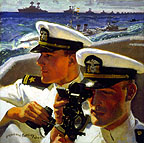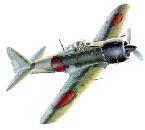el cid again
Posts: 16922
Joined: 10/10/2005
Status: offline

|
The Doro Nawa Unit was an ad hoc, military staff assigned (under the energetic and creative and brilliant Col Masanobu Tsuji) by Gen Yamishita to plan for the invasion of Malaya. As Col Tsuji notes in his book (Japan's Greatest Victory, Britain's Worst Defeat) - there had been no prewar military (vice naval) planning for war with the USA or British Commonwealth. There was simply no staff work to draw upon, not even intelligence. Tsuji was part of that staff, as was a full captain of the Navy. Its formal name was Taiwan Army No 82 Unit and it sometimes also was called the Taiwan Army Research Unit. The commander was Gen Itagaki. Its size was 30 en toto, including "servants and typists" - an ideal size for a planning staff (not so big people waste time writing memos, they just talk to each other).
Scenario 105 assumes that Gen Yamashita proposed, and the Imperial General Staff implemented, a similar national staff. This staff has an executive committee of five - Gen Yamashita (theorist of armor and combined arms), Vice Adm Hosogawa (theorist of the Kiddo Butai), and a Vice Minister from the Foreign Ministry, the Ministry of Commerce, and the Ministry of Finance. This body met continuously in July 1941, and monthly thereafter until November, when the military members left to take up their wartime posts - replaced by one star officers who would travel to consult with them during the war - and who acted as their personal representative on the committee. The staff itself was nominally supervised by prince Tsuneyoshi Takeda, a staff officer with the Imperial General Staff in 1940, in charge of the personal section. [He had served as chief of finance of Kwangtung Army, and as a junior officer, in cavalry in Manchukuo] This was a small joint staff, with representatives from various military, naval and government branches, including the Nakano School, the submarine arm, artillery, and the Kempeitei (intellegence section) and Tokkeitei (Naval intelligence), as well as experts in finance and industry.
The staff only forms up in July, 1941, after the decision to mobilize is made, in the context of the capture of British plans by a German raider, which were turned over with permission from Hitler IRL (a story in itself, complete with how the messages were sent but not intercepted by Ultra). The committee was unable to change anything which had happened before it formed, and it needed time to decide what other changes to implement? For this reason, Scenario 105 assumes only minor impacts by the time the war begins, and capital construction impacts cut in more and more over time. It makes no attempt to device theater strategies - except for guidance about joint policy. Like the real Doro Nawa ("robber rope" - more or less "barn door brigade" for the English idea of "it is too late to lock the barn door after the horse is stolen" - implying the planning should have been done long ago) unit, this fictional one requires joint cooperation between Army and Navy and civilian ministries - itself a rather profound concept in Imperial Japan.
Since aircraft carriers were already clearly important, and since VADM Hosogawa is a carrier vice a battleship advocate, the first strategic investment decision was made in re carrier construction. Both the USA and Japan found steel to be the second most critical strategic material, after oil. The amount of steel produced is approximately constant, and grows only slowly over time, if at all. It is vital to vastly different things (rails for trains, frames for factories or bridges, tanks, guns of all sorts, warships, vehicles, etc). Similarly, the output of engine plants for large ships is approximately constant. The number of large, high speed hulls is essentially limited - not subject to the whim of "we want more of those" alone. So the decisions were made in the context of hulls already laid down, as well as how fast new hulls might be produced, at a very limited rate?
The first decision was with respect to the four large battleships under construction (two laid down in 1940, two others much earlier nearing completion). Aside from the potential use of battleships as such, and their many advocates in the Navy, there also seemed to be, in 1941, a real requirement for such vessels, and tearing apart hulls almost ready for service to get carriers years later in time didn't make sense compared to battleships operational in 1942. So Yamato and Musashi survived the review. Shinano and Hull 111 (probably named Kii) didn't. Construction was suspended IRL, but this staff decided to keep building the hulls as designed, and to keep building the engines for them, while directing a specialist staff to design a carrier variation - very similar to what happened to Shinano in 1942 except these two ships were to be full operational carriers. Big enough to hold on the order of 120 planes, for code reasons, and because the planes will be larger by the time the ships are completed, this design is "limited" to 96 - still bigger than any others in Japan. They also get new names - to confuse the enemy in case they had detected the construction of the battleships - and not imply their huge size. They will be called Owami and Iwari. Not being delayed by suspended construction, or even waiting for plans for the carrier version to be drawn (it takes time to build the hull and the redesign would preserve that portion), these ships could complete (if industry remains productive) as early as 430219 and 430822. These ships get four squadrons - the classical fighter, dive bomber and torpedo bomber mix - all at 27 planes - with a smaller squadron of carrier recon planes (which could be replaced by carrier night fighters later on).
The second decision was related to plans to lay down another large carrier in July, 1941 - the improved Shokaku armored carrier Taiho. It would require three years to complete, and in spite of a decision to order a sister, as well as plans to order an early version of Unryu, the second Taiho never laid down and the Unryu needed a year more staff work before the first three began in August and later in 1942. The staff decided that losses in war were likely, that expanding the carrier force if there were no losses was useful and a good counter to likely enemy construction, and that the best compromise was to immediately order a pair of repeat Soryu class ships - to complete in two years. Not waiting until 1942 to begin construction, and using material assembled for Taiho to begin the first in July, 1941, these could complete (if industry remains productive) as early as 430706 and 430710 (never mind the second unit starts building more than a month later in time, based on historical construction performance of the first two Unryus). These ships get similar air groups to the real Unryus - three squadrons with 18 fighters, 18 dive bombers and 18 torpedo bombers - supported by a section of 9 carrier recon planes. These ships will use the first two Unryu class names, Unryu and Amagi.
The shadow program producing the Hiyo and Junyo was also retained, so both ships will appear in 1942 as IRL. These retain the historical air groups.
Later construction was of the Unryu class - slightly enlarged Soryu's - with two in 1942 able to complete in 1944, again as IRL as early as 440806 & 440810. These will use the second pair of historical Unryu class names, Katsurigi and Kasagi. These retain the historical air groups, the same as described above. Another pair laid down at the end of 1942 and start of 1943 can complete early in 1945. These will use the third pair of historical Unryu class names, Aso and Ikoma. If no construction delays, unlike real life, earliest completion is possible 450106 and 450110. The staff decided to order two more units to lay down later in 1943, as a replacement unit for assumed war losses. Named Kurama and Azuma, they could complete as early as 450613 and 450617. While these numbers are insufficient to compete with likely Allied construction, it is the most Japan can reasonably afford. Japanese strategy assumes the war must be won early, and that it cannot compete in a long term building contest with the USA, so later construction will focus on defensive ships and ships with the potential to convert to peacetime use.
< Message edited by el cid again -- 4/30/2012 6:08:31 PM >
|
 Printable Version
Printable Version













 New Messages
New Messages No New Messages
No New Messages Hot Topic w/ New Messages
Hot Topic w/ New Messages Hot Topic w/o New Messages
Hot Topic w/o New Messages Locked w/ New Messages
Locked w/ New Messages Locked w/o New Messages
Locked w/o New Messages Post New Thread
Post New Thread